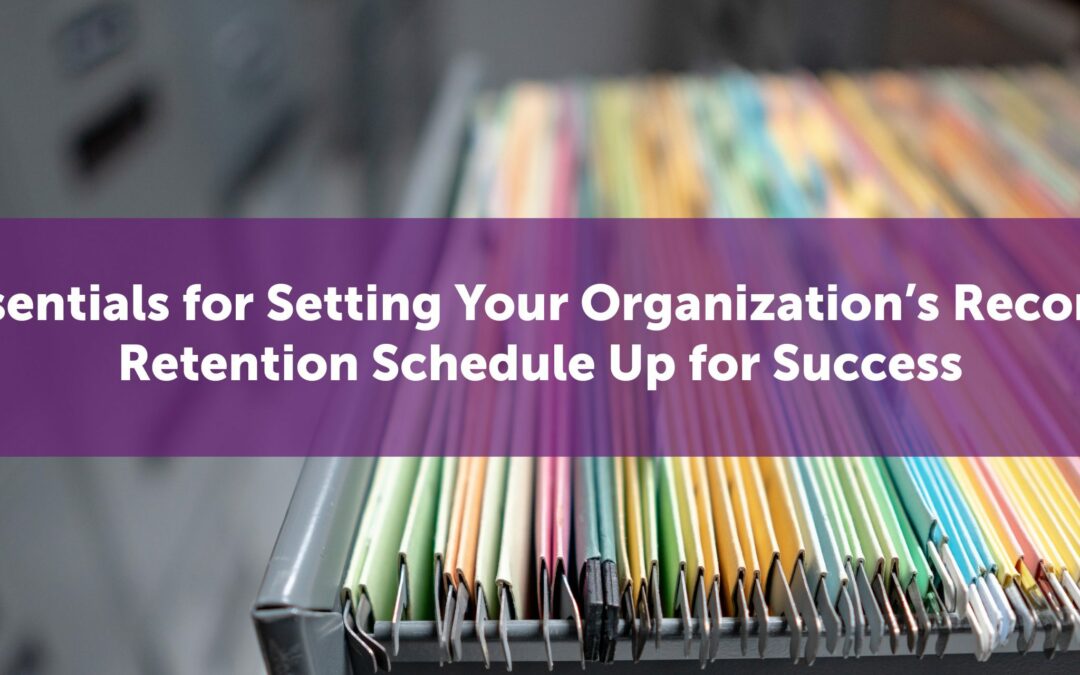This three-part series will walk readers through several best practices surrounding RRS development and maintenance. Part 1 is an overview of best practices for information collection in support of designing and developing a customized retention schedule. Parts 2 & 3 will explore detailed practical approaches for building a simplified RRS and regularly maintaining that RRS to keep it current and relevant.
Information Collection – Overview & Objectives
The key objective of RRS development is to create a customized RRS that is tailored to the organization and reflective of its processes and operational information requirements. A template retention schedule may be suitable for some organizations in the early stages of their RIM program, but it is unlikely to fully address the complexities of each organization’s unique processes and culture. A customized RRS that includes all of the organization’s general business and industry-specific processes helps ensure that end-users can quickly and accurately identify their processes and records in the retention schedule, significantly enhancing ease of use and compliance outcomes. It is vital that the RRS be transparent and intuitive so that personnel can understand where their records fall within the RRS. This is important because end-user adherence increases compliance.
The information collection process gathers the details necessary for customization from knowledgeable individuals and record owners across the organization. At a minimum, this includes information detailing typical example record types and the business processes they support, an assessment of the short-term and long-term ongoing business and operational value or each record type, and any specific retention requirements of the business. Additional details can be captured during this time as well, including information on paper or electronic format requirements, storage locations, the presence of personal data, and any other information supporting classification. In the interest of efficiency and even bolstered backing and buy-in, an information collection exercise can also often align and achieve synergies with other parallel organizational projects and objectives including a data mapping project, a data privacy assessment, a full records inventory, or a records classification project.
The preferred method of information collection is to first distribute a survey that clearly lays out the information desired to be captured and allows participants ample time to provide responsive information. Once the surveys have been returned and analyzed, schedule a follow-up interview with each survey respondent to obtain additional details and clarifications. An additional important objective behind these interactions is building rapport with the record owners and other knowledgeable individuals within your organization – they will be critical to later implementation, so baking in their concerns and priorities from the outset can help prevent friction and significantly streamline the roll-out of the RRS. They will also be more likely to act as champions and proponents for compliance when they feel that they have “skin in the game” on the RRS. You may even be able to identify certain individuals well situated to act as records coordinators or to liaison with existing records coordinators. Information collection is the ideal opportunity to build partnerships to reinforce the RRS’s importance and lay the groundwork and support for additional RIM processes and initiatives as you continue to develop your program.
Conclusion
Ultimately, a robust information collection process will yield a comprehensive picture of an organization’s records and the processes they support. It is an essential step in the process of creating a bespoke RRS that is organic, intuitive, searchable, and end-user friendly. Equally important, it builds consensus and recruits champions for your RRS. In summary, thorough and comprehensive information collection lays the solid foundation needed to support the ultimate end goal: adherence and successful implementation of your RRS!
Disclaimer: The purpose of this post is to provide general education on Information Governance topics. The statements are informational only and do not constitute legal advice. If you have specific questions regarding the application of the law to your business activities, you should seek the advice of your legal counsel.

Author: Jennifer Chadband, IGP, CRM, ECMp
Senior Analyst / Licensed Attorney

